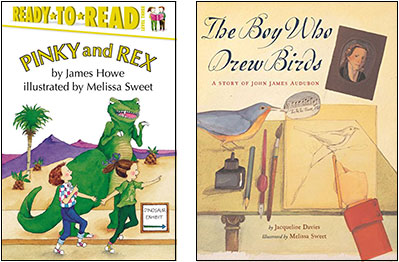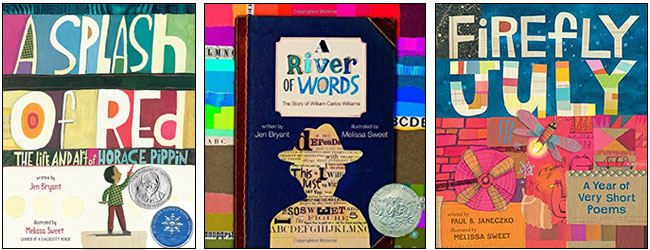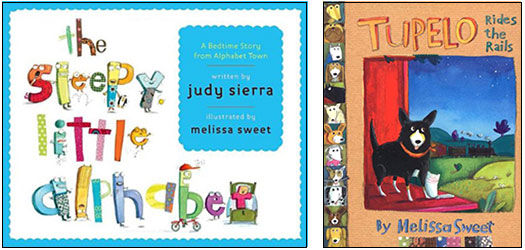 In my next life, I’m coming back either as a cat living in our house (think Canyon Ranch for cats), or Melissa Sweet. I’ve followed her career since she illustrated James Howe’s Pinky and Rex (1990). I love this book for its atypical characters (Pinky is a boy who loves pink and stuffed animals, and Rex, his girl friend, is into dinosaurs), but also for Melissa’s fresh-faced characters and bright watercolors.
In my next life, I’m coming back either as a cat living in our house (think Canyon Ranch for cats), or Melissa Sweet. I’ve followed her career since she illustrated James Howe’s Pinky and Rex (1990). I love this book for its atypical characters (Pinky is a boy who loves pink and stuffed animals, and Rex, his girl friend, is into dinosaurs), but also for Melissa’s fresh-faced characters and bright watercolors.
Then I heard her speak at a conference in 2005 about illustrating The Boy Who Drew Birds by Jacqueline Davis. I was enchanted by the collaged snippets — maps, music notes, handwriting — among her watercolor illustrations. One double-spread showcases a dried frog, a nest with eggshells, a dried lizard, lichen, a tiny skull. An insatiable collector, she used what was in her studio.
I too am a collector. I have at least 20 vintage suitcases filled with old magazines, photos, office supplies, scrapbooks, bought because people dump greeting cards, photograph albums, report cards and I have this pathetic need to rescue unwanted family memorabilia.

I was moving away from scrapbooking to making — well, weird stuff. Seeing Melissa’s work, I realized I was creating mixed-media collages with heritage photographs (I never scrapped regular photos, like trips to Disney World, because I never went anywhere). Melissa uses collage to “say what I need to say.”
Each book got better: A Splash of Red: The Life and Art of Horace Pippin, A River of Words: The Story of William Carlos Williams (both written by Jen Bryant), Firefly July: A Year of Very Short Poems (written by Paul B. Janeczko). Then Melissa wrote and illustrated Balloons Over Broadway, about Tony Sarg, puppeteer and creator of the Macy’s parade balloons. She made toys and puppets to understand what it “felt like to be in Sarg’s world.” I pored over the art, realizing how committed Melissa was to the research and her illustrations. She takes no shortcuts.

In The Right Word, she stepped up her game. The assemblages in the final double-spread caused my head to explode. And then … Some Writer! The Story of E.B. White, a mash-up of older kids’ nonfiction, picture book, and scrapbook. After I came to from swooning, I carried it around and made people look at it. Much of the art is contained in shadow boxes, like those of Joseph Cornell. If I had to choose a favorite, it would be the scene of Wilbur at the fair.

Being a Melissa Sweet fan, I’ve learned it’s possible to combine research, art, words, and found things into a project. A few years ago, I began making scrapbooks for my novels, a sort of illustrated outline. From magazine clip files, I choose images that represent a character or scene. By not trying to match an image to what’s in my head, I keep the story mine. I add bits of dialog and description. If the story changes, that’s okay. I just keep moving forward in both the scrapbook and the writing.
The book I’m working on now is complex in setting, characters, and plot. I’ve started a new scrapbook, but the vintage and modern magazine images don’t seem to be enough. It needs real art. I’m not an artist, but I decided to include a drawn animal character, sort of the way Melissa Sweet combines watercolor paintings and collage. Draw like she does! But her art is deceptive. I gnawed my fingernails studying the expressive slant of the dog’s ears in Tupelo Rides the Rails. It looks easy — it’s not.

Illustrator Trina Schart Hyman once wrote about trying to copy the style of Tomie dePaola. In ten minutes, she figured, she’d whip up a “Tomie” drawing. “Six hours later sweaty, frustrated, and thoroughly puzzled, I tore up the thirty-eighth ruined piece of paper in despair,” she admitted. His folksy style and childlike color was more sophisticated than she realized. If an accomplished artist like Trina Hyman couldn’t imitate Tomie dePaola, there was no hope for me to draw a Melissa Sweet-type cat. One pen line on my finished scrapbook page, and it would be ruined.
Paging through The Sleepy Little Alphabet by Judy Sierra, I noticed Melissa Sweet’s clouds. They appear to be penciled on graph and loose-leaf paper, cut out, and pasted on watercolor skies. I could draw cats on notebook paper, snip out one that isn’t too awful, and paste it in my scrapbook! Using unimportant paper makes the drawing seem less precious and should lessen my anxiety.
In her author’s note for Balloons Over Broadway, Melissa stresses she tried to convey the sense that her subject was having fun. “[Sarg’s] legacy reminds me that ‘play’ may be the most important element in making art!” A sense of play is a hallmark of Melissa Sweet’s work. A lesson for all of us who make children’s books!

I LOVE THIS. I, too, am a huge Melissa Sweet fan, but I had never thought about what her process (certainly it wouldn’t turn out like her art!) could mean for my writing. This caught my eye and made my heart go pitter-pat: “I have at least 20 vintage suitcases filled with old magazines, photos, office supplies, scrapbooks…” I might start a new practice this summer.….
Melanie, oh, I’m warning you – you’ll be hooked! I can’t leave behind anybody’s old greeting cards or school pictures or report cards. I have scrapbooks that tell entire childhoods, one tells a couple’s entire life. Sometimes I frame the photos and set them out. Stories are told in ephemera – things aren’t meant to last, but somehow do. Did I mention I also buy lots from Etsy of 60s Polaroid photos that I keep in a vintage 45 record case? It’s a sickness …